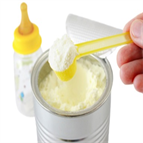Find methods for your needs
Refine by Feature
Displaying 1-3 of 3 results for Tag: Aria
Analysis of (Fluoro)quinolones in Honey with Online Sample Extraction and LC-MS/MS
Instrument Type: LCMSMSQuinolones, including fluoroquinolones, are a group of synthetic antibacterial compounds used in the treatment of several diseases. The presence of these compounds is an indication of unsafe practices of food production and deficient methods in the production of honey. We developed a sensitive and reproducible LC-MS/MS method for the quantitation of 12 fluoroquinolones and 4 quinolones in honey using automated extraction by TurboFlow technology as an alternative to the commonly used, time-consuming solid-phase extraction (SPE) method.
Determination of Bisphenol A in Infant Formula by Automated Sample Preparation and Liquid Chromatography-Mass Spectrometry
Instrument Type: LCMSMS2,2-bis(4-hydroxyphenyl) propane, commonly known as Bisphenol A (BPA), is one of the primary chemicals used to make plastics. It is also heavily used in the production of various types of food and drink containers. Because BPA has been known to leach from the plastic lining of metal canned food, the potential risks of exposure to BPA have been a great concern over the past few years. We describe a six-minute LC-MS/MS method using automated sample preparation for the assay of BPA in canned infant formula powder by negative ion APCI using a deuterated internal standard (BPA-d16).
Measurement of Chloramphenicol in Honey Using Automated Sample Preparation with LC-MS/MS
Instrument Type: LCMSMSChloramphenicol (CAP) (Figure 1) is a bacteriostatic antimicrobial previously used in veterinary medicine. CAP has been found to be potentially carcinogenic, which makes it an unacceptable substance for use with any foodproducing animals, including honey bees. We describe a quick, automated sample preparation, LC-MS/MS method for chloramphenicol (CAP) in honey by negative ion heated electrospray ionization (H-ESI) using a deuterated internal standard (CAP-d5).



